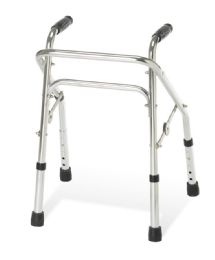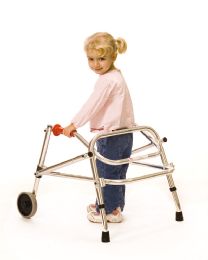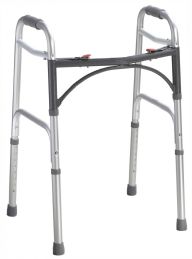
Ambulation is the ability to walk from place to place, but this can be difficult for children with physical challenges. Pediatric walkers enable a child to be independently mobile for healthier growth and development.
Rehabmart is proud to offer a wide assortment of pediatric walkers and gait trainers from top quality vendors which include Kaye Products Inc., Drive Medical, Medline, MJM International, Pacific Rehab Inc., Invacare, Independence Medical, TherAdapt, TFI Healthcare and more.









Pediatric walkers are different from adult walkers in many ways. Walking aids for children are normally adjustable so they can take growth development into account, and several models also provide postural correction and gait training. A gait trainer is a safety roller with or without a seat or harness that gives children self-confidence as they are encouraged to take steps. It can be designed as an anterior unit, a posterior unit, or have both units combined.
How are Pediatric Walkers and Gait Trainers Different?
Pediatric walkers and gait trainers are very different devices that are uniquely adjustable for different levels of development and requirements. A pediatric walker is used when a child is already able to bear weight and take steps, and basically uses the walker for balance support. A gait trainer is used when a child needs to learn to walk, to improve their walking ability, to develop weight-bearing strength, and to develop a healthier gait. A gait trainer uses supportive prompts to enable active participation by the child and promotes valuable motor learning, adaptive mobility, and strength gains. Children are able to practice walking in a natural manner as they propel themselves forward with the same motions as someone walking unassisted. The supportive prompts can be removed as the child improves function, gains skills, and achieves greater ambulation independence.
Various disorders can result in the inability to walk independently, making it necessary to use a gait trainer. Such motor disabilities may be due to a medical condition, such as spina bifida, cerebral palsy, or other developmental conditions. Recent discoveries demonstrate the human potential for improvement in motor skills through activity-based therapy. Although complete independence in gait may not be achieved in every case, significant improvements can be made in muscle strength and motor control for walking through training.
What are the Benefits of Early Mobility?
The human body is made to be upright as the muscles, bones, organs, and nervous system function the best when standing or walking. Normal hip alignment happens through the development of movement in the first year of life. Active movement and weight bearing cause the femoral head to develop properly to enable the hip to extend and externally rotate. Standing helps the femoral head to be positioned in the hip joint correctly, resulting in a more stable hip structure. Weight bearing and gait also aid in the development of better knee and foot alignment. Being upright and standing improves range of motion and prevents contractures that can happen when sitting in a flexed position. Standing also has a positive effect on decreasing the effects of spasticity, which can decrease pain and improve overall alignment.
Bone mineral density loss can be caused by a lack of weight bearing, which can result in osteoporosis and a higher risk of fractures. It is important for weight bearing activities to be routine and regular to maintain and continue development and bone growth. When standing, there is more space in the abdomen for the organs to function better, and there is an increase in lung volume for better breathing. A natural increase in awareness occurs when a child is upright, benefiting them while learning throughout childhood.
Infants and toddlers who seek out stimulation in their environment at an early age demonstrate greater academic, cognitive, and neurophysiological performance later in life. This may be because those who can interact and explore within their surroundings and with others in it, will continue to develop an environment for themselves that will be varied, stimulating and challenging. Motor interactions allow children to learn about their world, becoming initiators and active participants in life, and about their own ability and power to make things happen. All of this encourages a child to develop further independence.
How do I Choose a Pediatric Walker or Gait Trainer?
When choosing a pediatric walker or gait trainer there are many options, depending on a child’s needs and desired results. Consider the amount of support a child needs; do they need a head rest or trunk support, and what kind of pelvic support is required? Next, consider how the child will hold onto the device and in what position; are forearm supports needed? To better facilitate stepping, does the upper body need to angle forward? Leg tone and positioning should also be considered; do the legs contracture or scissor?
For a child who tends to scissor and has increased adductor tone, ankle straps or prompts that can help decrease scissoring may be useful. For a child with decreased head control, consider a head support on a gait trainer. Trunk support and forearm prompts may provide control that can encourage head lifting. For a child with little endurance and strength, a gait trainer with a saddle or seat can allow short periods of sitting and resting. Some children tend to pull into a strong flexor pattern when using a handhold or forearm support. This can cause poor control and posturing. These children may benefit from using only a saddle and trunk support.
Hulet Smith, OT
Rehabmart Co-Founder & CEO
lb